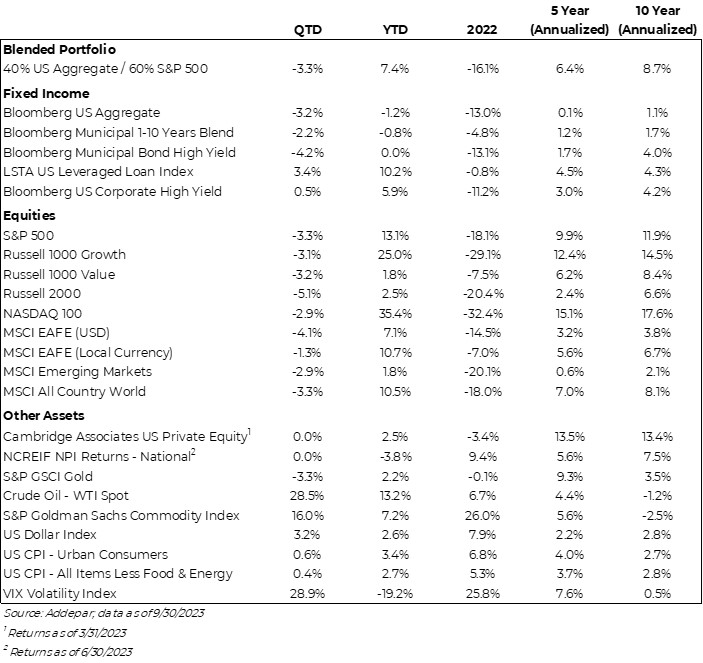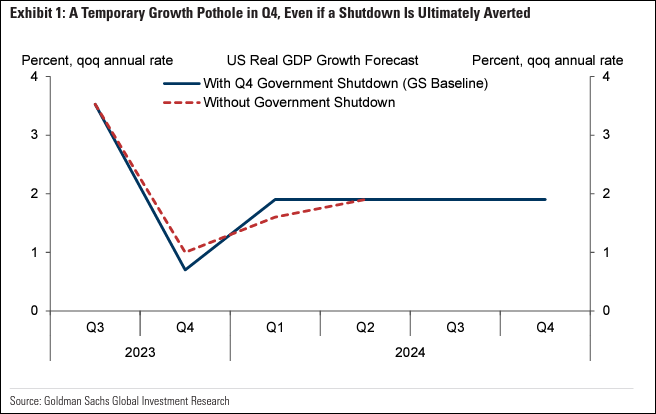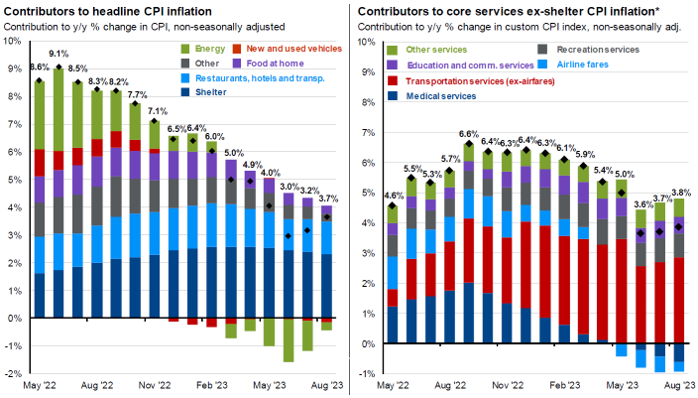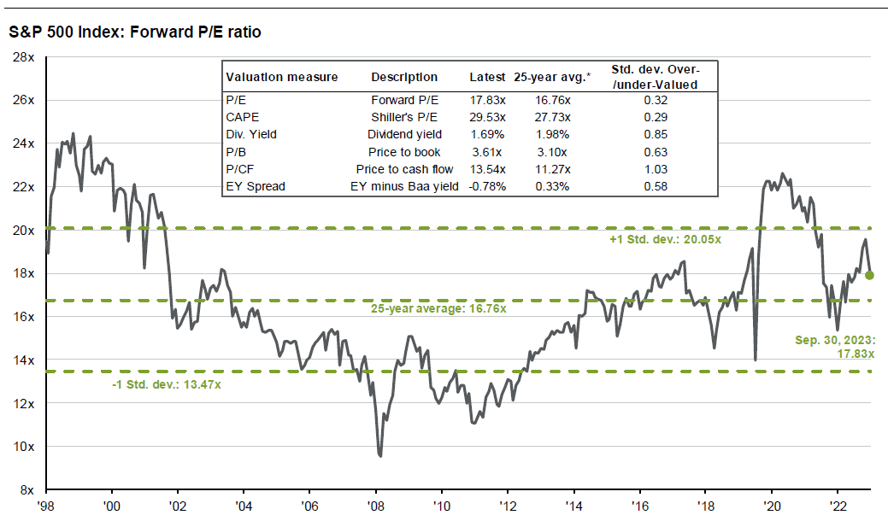SAGE MOUNTAIN 945 East Paces Ferry Rd NE, Suite 2660, Atlanta, GA 30326
SAGE MOUNTAIN RESEARCH
Market Update – Q3 2023
Seasonality held true, as the broad markets across stocks and bonds sold off during Q3
In Q3 investors became increasingly confident in a “soft landing” or even a “no landing” scenario for the U.S. economy. Both a healthy job market and surprising resilience in consumer spending resulted in shifting expectations. On the other hand, the rate cuts many hoped for penciled in for 2024 are much less likely, even though the underlying inflation trend is moderating quickly.
These “higher for longer” rate expectations, combined with rising oil prices during the quarter, played into a selloff in the best performing technology groups in Q3. The “Magnificent Seven” stocks that have been powering the market in 2023 pulled back. Value stocks performed relatively better, particularly dividend payers. These stocks most likely performed better as something of a risk-off trade. Energy stocks were the best performers thanks to a rise in oil prices engineered by Saudi production cuts.
In the bond market, yields rose to their highest levels since 2007, and U.S. Treasury bonds suffered. The concern was duration (interest rate sensitivity), not credit, as floating rate loans and high yield bonds outperformed.
The broad investment grade bond market is on track for its third straight year of losses, and research from Bank of America shows that Treasury bonds are in the midst of the greatest bear market of all time.
Labor market gains had been steadily easing throughout the year before a surprise uptick in new payrolls and job openings in the most recent monthly releases. Time will tell if those were just monthly noise or the start of an upward trend. Despite the strong job gains, wage inflation continued to trend down towards levels that are consistent with the Fed’s inflation target.
Looking ahead, the near-term outlook for investor portfolios appears to ride on how long interest rates stay high, as well as geopolitical worries and the progress of China’s recovery. The U.S. economy is positioned to continue to grow at a moderate pace. While Bankrate’s survey of economists shows that estimated odds of a recession in the next 12 months have fallen from 65% to 46% over the past year—and Goldman Sachs places the odds much lower at 15% — with expected real GDP growth in the 1-2% range the economy may be more sensitive to shocks as it continues to digest the impact of higher rates.
Market Snapshot
Investment grade fixed income was down again in Q3 as rates rose, while high yield outperformed as credit spreads remained tight.
Equities reversed course in the third quarter as broad indices fell globally. The S&P 500 fell 3.3%, while international stocks shed 4.1%.
After falling for the first half of the year, oil prices rebounded 28.5% in Q3. The US Dollar bounced back, rising 3.2% in the third quarter and bringing its year-to-date return positive.
Volatility rebounded sharply in Q3 as volatility spiked leading to a 28.5% increase in the VIX index, albeit from low levels.
A 60% equity / 40% bond portfolio fell in Q3, posting -3.3% return as both stock and bond markets fell.
Illustrative current positioning and asset class views
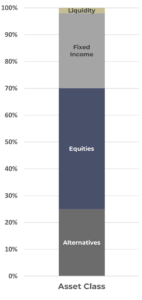
Cash
- Unlike recent years, holding cash remains an attractive option. With yields on money market funds near 5.00% or higher, we strategically utilize those high yielding cash instruments to earn income while ensuring we meet clients’ liquidity needs.
Fixed Income
- Government Bonds: In the US, the Fed funds markets seem well priced for “higher for longer.” However, without a stabilization in medium term inflation expectations, and with political risk looming given the leadership battle in the House that could be bearish for Treasuries, we remain reluctant to add duration now.
- US Investment Grade: The strengthening economy has been supportive of credit markets, both high yield and investment grade. Spreads are tight and thus may be fully valued for now. We are tactically allocated to AAA CLOs as they offer higher yields than investment grade corporate bonds and comparable yields to municipal bonds net of taxes.
- US High Yield & Leveraged Loans: Most analysts expect an erosion in the economy and corporate fundamentals to slightly push out spreads of higher risk credit investments. However, the economy has experienced less distress and more resiliency than expected. A continuation of that trend would likely result in tighter spreads and higher prices.
Equities
- US: Interest rates are higher and QT headwinds (central banks allowing their bond holdings to shrink) are now stronger with tightening also in Europe and Japan. Geopolitical factors have further deteriorated as well. However, earnings revisions seem to have bottomed and are moving higher, and the trend in core PCE inflation is clearly down. This brings us to a neutral stance on stocks.
- International: While valuations for international stocks remain lower than the U.S., so do their growth prospects. Europe and the U.K. remain weak, with discouraging economic data. In China, the recovery is shaping up to be weaker than expected. For various reasons, it will be more difficult for China to spur growth through infrastructure spending which is their authorities’ preferred tool. We don’t see a reason to suggest getting more bullish on international stocks at this point.
Alternatives
- Alternative lenders may benefit from stress at regional banks. We expect more borrowers to turn to private credit as it becomes relatively better priced and given the certainty of execution and long-term partnership. We are leaning into private real estate debt which may benefit from a similar dynamic, while becoming much more cautious on new real estate equity commitments which will need to overcome borrowing costs that have increased more than cap rates. The slowdown in venture capital fundraising and deals may make this upcoming cycle a good time to participate in the sector. We also believe secondaries funds across strategies are well positioned to capitalize on the current environment.
The U.S. economy should slow in Q4, but underlying strength will likely remain.
We expect US GDP growth to slow in Q4. There are a handful of reasons for this. First, the end of the student loan moratorium will take some spending out of the economy. Second, labor unrest, particularly the UAW strike, should slow production and spending. Third, the recent increase in oil prices, possibly exacerbated by the horrific events in Israel, will also serve as a drag. Lastly, the apparent slowdown in consumer spending seems likely to worsen. Goldman Sachs estimates that real GDP growth will slow from 3.5% in Q3 to 0.7% in Q4.
Inflation continues to fall; will it stay manageable?
Following two years of raging inflation, we seem to have a steady downtrend in CPI inflation. After peaking at 9.1% in June of 2022, CPI inflation has fallen to 3.7% in August of 2023. Additionaly, core inflation has continued to decline after peaking close to a year ago. The headline disinflation has been driven by reversals in energy costs since 2022 along with other major causes such as vehicle sales and shelter costs. While inflation is above the 2% Fed target, the sustained decrease is an encouraging, but cautious, sign.
Depleted savings and housing unaffordability will likely crimp consumer spending
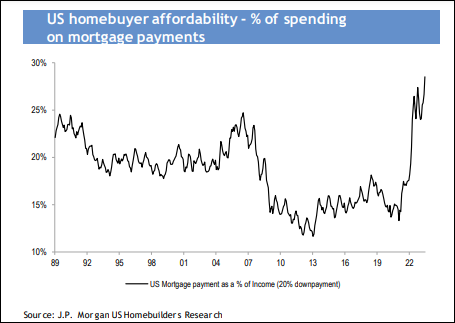
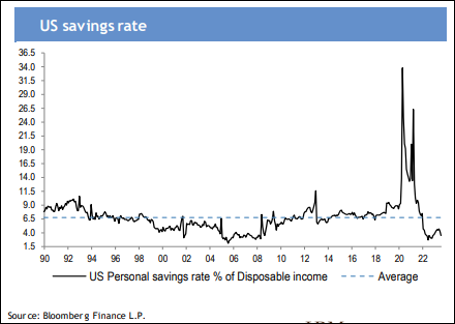
The charts above highlight two possible reasons for a slowing in GDP in the near future. For equities, this could be good or neutral because of less pressure on interest rates. The chart on the left shows that housing affordability is low (costs are high), which should slow demand. The chart on the right shows the savings rate, which was massively boosted by COVID stimulus payments. It has now returned to more normal levels.
Financial markets are focused on interest rates, now more than ever
During the quarter, the bond market largely came around to the Fed’s point of view that it would be taking a tough line against inflation via hiking rates and holding them high.
The Fed raised its benchmark Federal Funds rate an additional 0.25% in July to a target range of 5.25%-5.50% then held rates steady at their September meeting. The Fed has raised rates by 1% so far this year, a much slower pace relative to the 4.25% increase in 2022.
Signs of progress on inflation, the move up in longer term rates potentially doing some of the Fed’s work for them, and recent statements from several Fed members have largely convinced the market that Fed is done raising rates for this cycle. Current odds indicate less than a 10% chance of a hike in November and less than 30% in December.
We expect that the debate will now shift to the timing and pace of rate cuts which are now expected to begin in 2H 2024. However, a significant growth scare or “financial accident” in the markets could accelerate the Fed’s response.
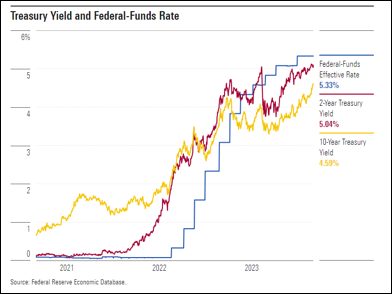
Expected short term interest rates have stabilized and are now expected to remain “higher for longer”
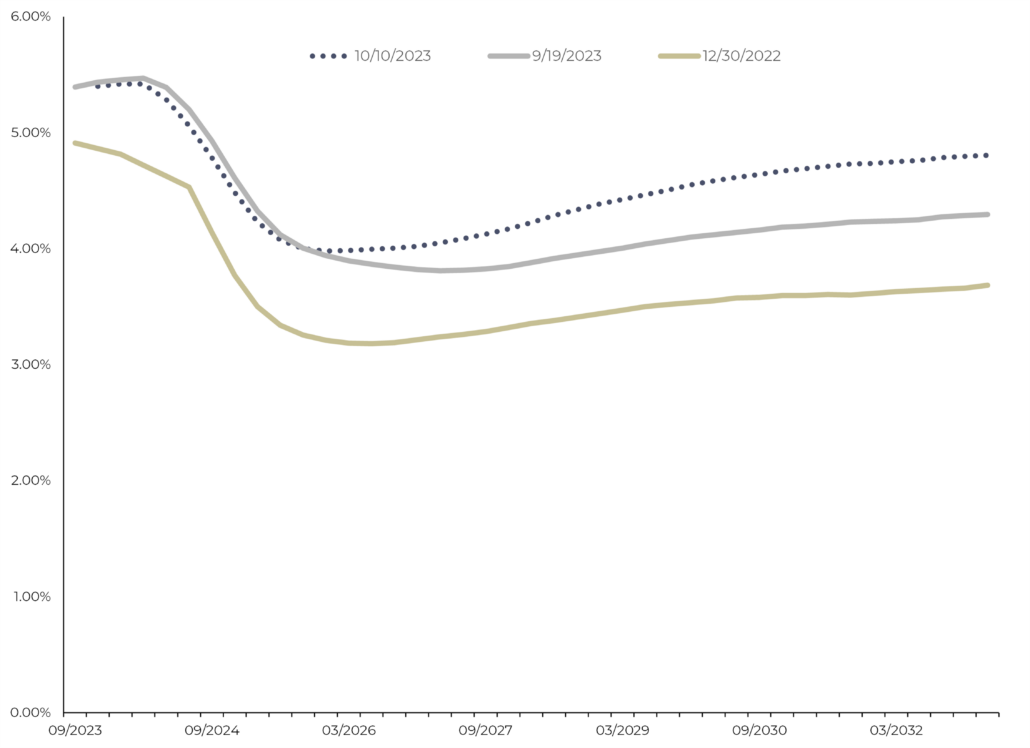
The chart shows market-implied yields for 3-month SOFR futures, a proxy for the Fed Funds Rate.
The “higher for longer” theme continues to gain traction as evidenced by the further steepening of the forward curve after the Sept. 20 Fed meeting.
Surprising some, the earnings outlook has strengthened…
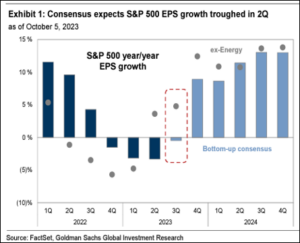
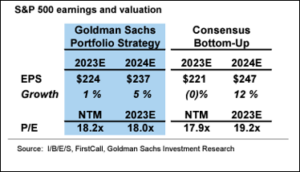
As noted on the left chart, consensus expectations are for earnings to have troughed in the second quarter, with a return to positive territory in Q4.
…in this context valuations are above average but not unreasonable.
Manager selection continues to be paramount…especially in private markets.
Manager selection in public markets is always important, but it is crucial in private markets. This drives our philosophy to invest mostly passively within our public market allocations while focusing more on sourcing and analyzing opportunities in the private markets.
The return dispersion, as illustrated below, between the top and bottom quartile private fund managers over the last 10-years is vastly larger versus public markets. Given the illiquid nature, lack of public information, and longer time horizon, private markets require strict and through due diligence to select best in class managers for investments.
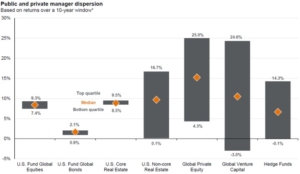
Source: Burgiss, Morningstar, NCREIF, PivotalPath, J.P. Morgan Asset Management
Disclosures
Past performance is not indicative of future results. Sage Mountain Advisors, LLC (“SMA”) is an independent SEC registered investment advisor. Any reference to or use of the terms “registered investment adviser” or “registered,” does not imply that SMA or any person associated with SMA has achieved a certain level of skill or training. This material is provided for informational and educational purposes only.
Any subsequent, direct communication by SMA with a prospective client shall be conducted by a representative that is either registered or qualifies for an exemption or exclusion from registration in the state where the prospective client resides. For more information pertaining to the registration status of SMA, please contact SMA or refer to the Investment Adviser Public Disclosure website (www.adviserinfo.sec.gov). The information contained herein should not be construed as personalized investment, tax, or legal advice. Certain information contained in this presentation has been derived from third party sources. While we believe these sources to be reliable, we make no representations as to the accuracy, timeliness, and completeness of any such information prepared by any unaffiliated third party incorporated herein, and take no responsibility therefore. As such, there is no guarantee that the views and opinions expressed in this presentation will come to pass.
All investments carry a certain degree of risk of loss, and there is no assurance that an investment will provide positive performance over any period of time. The statements contained herein reflect opinions, estimates and projections of SMA as of the date hereof, and are subject to change without notice. SMA reserves the right to modify its current investment strategies and techniques based on changing market dynamics or individual portfolio needs. The opinions expressed herein are those of SMA and are subject to change without notice. Information presented should not be considered as a solicitation or recommendation to buy or sell any security, financial product, or instrument discussed herein. Additionally, this material contains certain forward-looking statements which point to future possibilities. Due to known and unknown risks, other uncertainties and factors, actual results may differ materially from the results portrayed or implied in such forward-looking statements. Furthermore, the illustrative results presented in this presentation in no way reflect the performance of any SMA product or any account of any SMA client, which may vary materially from the results portrayed for various reasons, including but not limited to, investment objectives, financial situations and financial needs of SMA clients; differences in products and investment strategies offered by SMA; and other factors relevant to the management of SMA client accounts.
This presentation and its contents are provided “as is” without warranty of any kind, express or implied, including, but not limited to, implied warranties of merchantability, fitness for a particular purpose, title, non-infringement, security, or accuracy. SMA reserves the right to modify its current investment strategies and techniques based on changing market dynamics or client needs. It should not be assumed that any of the security transactions, holdings or sectors discussed were or will prove to be profitable, or that the investment recommendations or decisions we make in the future will be profitable or will equal the investment performance of the securities discussed herein.
Actual investment advisory fees incurred by clients may vary. A complete description of SMA’s fee schedule can be found in Part 2 of its FORM-ADV which is available at www.sagemountainadvisors.com or by calling (404) 795-4861. Clients are advised that no portion of the services provided by SMA should be interpreted as legal, tax or accounting advice. For legal and tax-related matters, we recommend that you seek the advice of a qualified attorney, accountant or tax professional. SMA-23-000512

